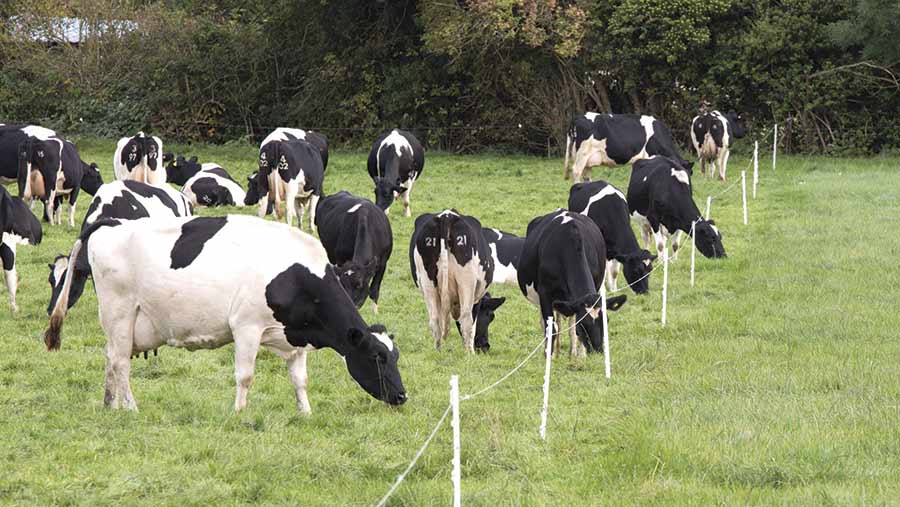Guide to setting up a grazing infrastructure
 © Tim Scrivener
© Tim Scrivener Low returns have forced many dairy farmers to turn their attention to grazed grass in an attempt to lower costs, but in order to make the most of farm resources, getting the right infrastructure in place is a must.
Bertie Troy, managing director for Grasstec, runs through some key areas to think about when investing in grazing set-up.
1. Map the farm
Drawing together a detailed map of the farm should be the first port of call.
This can be used to determine effective land area by removing any ungrazeable areas such as the farmyard and woodland.
This will ultimately impact stocking rates.
See also: Rethinking cattle performance workshops
Knowing where ditches and hedgerows will also influence where infrastructure, such as tracks, will go.
How to do it
A company can be employed to map the farm using a GPS system mounted on a quad bike.
They will then design and advise on infrastructure based on farm requirements.
Grasstec quote £8/acre to map and design infrastructure and provide ongoing support.
Alternatively, farmers can do a paper exercise using their own farm map.
Google Maps can also be used as a free tool to gain an overview of the farm.
2. Think about paddock size
Paddock size will depend on the land available, herd size and grazing period preference.
Farmers will need to decide if they want to graze for 12, 24 or 36 hours at a time and plan paddock size accordingly.
Example calculation
For a 200-cow herd, grazing in 24 hour periods, with average grass covers of 2,900kg/ha DM in the main grazing season and a target rotation of 21 days.
Every 40 cows need one acre (0.4ha) of land for every 24 hours, so the herd will need five acres (2ha) in 24 hours (200 cows divided by 40 equals five acres). So this farm should be split into five-acre blocks.
So this farm should be split into five-acre blocks.
3. Get the paddock shape right
Avoid long, thin paddocks to minimise damage by preventing cows from having to walk over the same area.
Aim for a ratio of 2:1 so fields are twice as long as they are wide. On wetter fields, a ratio of 1:1 may be more applicable to further reduce traffic damage.
4. Consider track type and location
Keep tracks as straight as possible.
Don’t be afraid to be ruthless in your design to achieve this (for example, going centrally down a field).
Track width will depend on herd size and location on farm. Generally, tracks should be wider the closer they are to the farmyard.
For example, 4-5m wide may be appropriate for most of the farm, while 6m may be better, close to the buildings.
Whether you choose railway sleeper tracks, stone, concrete tracks or astroturf will depend on material availability and location on farm.
All tracks should be free draining with a smooth, stone-free surface.
See also: Buyers guide to installing cow tracks
5. Plan water supply
Cows consume 80-120 litres of water a cow a day with most being drunk within 90 minutes of milking, so the water system must be designed to meet this demand.
Pipe and pump size are critical here.
Calculate how many litres a minute your system needs to deliver using:
Litres a minute = (number of cows multiplied 90 litres/day) divided by (number of times the herd is milked) divided by 90 minutes
For example, a 150-cow herd, milked twice a day, will need a system that delivers 75 litres/min.
The correct pipe and pump size will then need to be selected to achieve peak demand.
Arranging the pipes in a “loop system” rather than a single line (so that the water goes in two directions) can lead to a 40-50% increase in water flow through the same size pipe.
This results in more consistent pressure and flow rates to all paddocks.
6. Think about troughs
Troughs can be positioned underneath fence lines so they can be shared by two fields or placed in the middle of the field for larger herds, but should always be placed on hard standing.
Fast-flow valves are advisable over ball cock valves as they keep troughs filing at the same speed until they are completely full.
7. Get gate design right
Aim for at least two access points into a paddock to reduce poaching in wet weather and always have hardcore around the entrance.
Ensure gates are no narrower than the width of the track they are coming off.
Also, ensure the gate electric current goes through an earth wire to maintain a consistent flow of electricity.
8. Consider permanent fencing set up
When installing permanent, mains electric fencing, choose high-tensile wire and long-life timber posts.
An appropriately sized fencing unit will need to be attached to the mains to deliver electricity to the fence line.
The size of this unit will vary depending on the size of farm and length of fencing.
Justin Rees from KiwiKit emphasises the importance of installing a unit big enough to cope with any future expansion and variations in seasonal load caused by weeds and hedgerows shorting out the line.
A properly designed earth field –constructed to suit the energiser used – is also crucial to ensure the fence works at its optimum.
Example set up and costs from KiwiKit
A 22J output energiser is enough to power a 250-300 acre (101-121ha) farm or 256km of wire.
A single strand, high-tensile fence with insulators and fence posts 15m apart will cost from 28p/m without labour and about £1/m when using a contractor.
Grazing infrastructure – at a glance
- Mapping the farm should be the first priority – use this is a template for infrastructure
- Any infrastructure should take into account future expansion plans
- Where drainage problems exist, speak to a drainage expert before installing any infrastructure
- Put water in first, then tracks, then fencing
- Work on a factor of 40:1 when planning paddock size (40 cows to one acre)
- Generally use a factor of 2:1 when designing paddock shape
- Opt for wider tracks closer to farm buildings
Farm mapping provides template for expansion
Windmill Dairy, Oxfordshire

Chris Whitford
Mapping the farm and planning where to put grazing infrastructure has provided a template for expansion for the new spring block-calving herd at Windmill Dairy, Oxfordshire.
Having set up the herd on a greenfield site in September 2015, the decision was made to limit investment in permanent infrastructure in the first year and graze 90 cows on 80-90 acres (32-36ha).
However, following a successful first season, the business chose to open up the entire 460 acre (186ha) farm for grazing and increase numbers to 150 for the 2017 year.
In order to ensure any permanent infrastructure was laid correctly, the farm was GPS mapped by Grasstec in October 2016.
The final map was designed around milking a target 300 cows with fields split into 9.8 acres (4ha) paddocks to provide 24-hour grazings.
Water, tracks and electric were positioned accordingly.
Contractor, Chris Whitford – who is in a joint venture with David Christensen says: “The map provides a template for expansion so I know exactly where I need to go next.”
Investment in infrastructure will be gradual as the herd expands.
Only a few paddocks closest to the farm are currently split into 4ha.
As the farm is chalk with a clay cap, the ground can lay wet so fields closest to the farm have two entrances and one exit in a corner to enable on/off grazing at the shoulders of the season.
This season, upgrading the temporary water supply into a permanent system across the whole farm will be a priority, says Mr Whitford.
“A 50mm water pipe will go in round the farm and 42 water troughs. I hope to get the upgrade done by mid-March,” he explains.
The aim is also to have mains electric installed by the end of this grazing season.
This will be laid off the tracks and on the perimeters, with temporary electric used to split fields.
About 4,000 concrete sleepers were laid in the first season, with plans to put in another 9,000 to access the furthest fields.
“In hindsight, I wouldn’t have put in the sleepers before doing the mapping as they then dictated how to split the fields,” says Mr Whitford who aims to keep infrastructure expenditure to below £1,000-£1,200 a cow.
